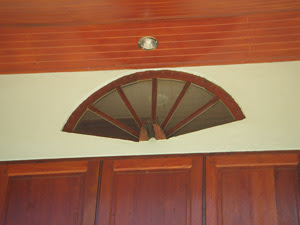The primary concerns with windows in Thailand are two fold: the first is light, the second is solar gain. In a way the two factors work against each other. The smaller the window the less the solar gain, but also the less light that will be let into a building.
In Thailand where the weather is really hot
solar gain
is a key issue. It is very expensive to run an air-con unit 24 hours a day. A fan or natural ventilation is much cheaper and more eco-friendly. It is not an option to not have windows only have tiny slit windows because then you rely on artificial light. Artificial light does not contain the full spectrum of light and can cause psychological problems such as S.A.D (seasonal adjustment disorder).
In this post I will look at the various methods there are to have windows but to reduce solar gain.
The first and easiest method is to use roller shades, vertical blinds or venetian blinds. The downside of this is that fabric quickly fades with exposure to the sun and having the curtains drawn all the time creates an unfriendly atmosphere to a house as viewed from outside. An outsider will subconsciously think that the resident is always sleeping or sick or just reclusive.
Another method to reduce solar gain is to use the house or villa construction. Especially for east and west facing windows that get a lot of light, building an awning above the window can reduce solar gain by up to 50%. Another method is to place a window under the over-hang of a roof.
A key consideration when planning windows for your villa is the frame material. The lower the conductivity of the frame material the less solar gain. The least conductive material is wood. The problem with wood is that it rots, especially in tropical weather where there is a lot of humidity and rain. To combat the wetness make sure drainage is used and treat the wood. Unfortunately, the chemicals used to treat the wood are not environmentally friendly. To maximize the effectiveness of the treatment and minimize the impact on the environment get the wooden window frames chemically treated in the factory and not on-site. For more on the treatment of wood and its environmental impact check out
NGS GreenSpec.
is becoming a popular frame material. It is low in conductivity (not as low as wood) and is durable. The downside is that it is a type of plastic and can ruin the aesthetic of a window in a Thai villa which might be aspiring to a traditional Thai feel. Finally, there are metal frames - they are the highest in conductivity but are very durable. Metal has a very modern feel and only suits modernist architecture in Thailand. Also it is the most expensive frame material.
The final way to combat solar gain is through using something other than just plain glass. Glass is tinted by changing the chemical properties of glass.
Tinted glass absorbs light and heat considerably better than normal glass. In some cases tinted glass can absorb as much as 50% of the heat coming from the sun. Unfortunately, a lot of that heat later seeps into the room via convection and radiation. And the other downside with tinted glass is that it dramatically reduces the amount of light let into a room.
The latest method to reduce solar gain through windows is to put a low-e coating on the glass. A low-e coating is a layer of metal only a few molecules in thickness. Most window manufacturers now put low-e coatings on all their windows. A low-e coating is very effective against solar gain. One coating is the equivalent of adding another pane of glass between a room and the sunlight. Low-e coatings are also better than tinted glass because they don't reduce the lighting in a room very dramatically.
Windows are a integral part of what makes a villa feel 'luxurious'. The psychology is obvious - windows promote a feeling of light, space and airiness, they provide panoramas of sea, mountain and jungle, they promise the immediacy of decking and pool, they bring the outside into the house and connect the two. A room with a view is a good room. A room without a view or even without a window is a prison cell. No windows equals claustrophobia and depression. The question is how to have windows and light without overheating your living space.





















